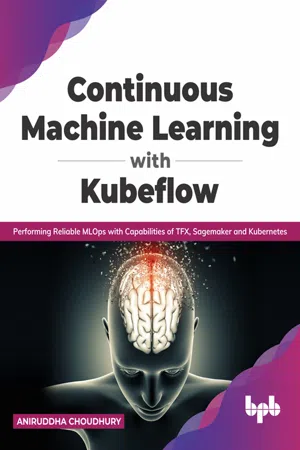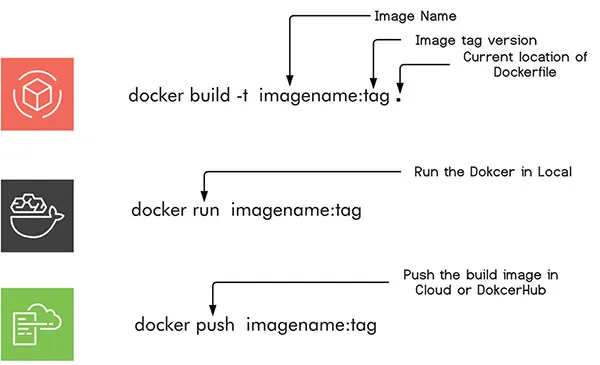
Continuous Machine Learning with Kubeflow
Performing Reliable MLOps with Capabilities of TFX, Sagemaker and Kubernetes (English Edition)
Aniruddha Choudhury
- English
- ePUB (handyfreundlich)
- Über iOS und Android verfügbar
Continuous Machine Learning with Kubeflow
Performing Reliable MLOps with Capabilities of TFX, Sagemaker and Kubernetes (English Edition)
Aniruddha Choudhury
Über dieses Buch
An insightful journey to MLOps, DevOps, and Machine Learning in the real environment.
Key Features
? Extensive knowledge and concept explanation of Kubernetes components with examples.
? An all-in-one knowledge guide to train and deploy ML pipelines using Docker and Kubernetes.
? Includes numerous MLOps projects with access to proven frameworks and the use of deep learning concepts.
Description
'Continuous Machine Learning with Kubeflow' introduces you to the modern machine learning infrastructure, which includes Kubernetes and the Kubeflow architecture. This book will explain the fundamentals of deploying various AI/ML use cases with TensorFlow training and serving with Kubernetes and how Kubernetes can help with specific projects from start to finish.This book will help demonstrate how to use Kubeflow components, deploy them in GCP, and serve them in production using real-time data prediction. With Kubeflow KFserving, we'll look at serving techniques, build a computer vision-based user interface in streamlit, and then deploy it to the Google cloud platforms, Kubernetes and Heroku. Next, we also explore how to build Explainable AI for determining fairness and biasness with a What-if tool. Backed with various use-cases, we will learn how to put machine learning into production, including training and serving. After reading this book, you will be able to build your ML projects in the cloud using Kubeflow and the latest technology. In addition, you will gain a solid knowledge of DevOps and MLOps, which will open doors to various job roles in companies.
What you will learn
? Get comfortable with the architecture and the orchestration of Kubernetes.
? Learn to containerize and deploy from scratch using Docker and Google Cloud Platform.
? Practice how to develop the Kubeflow Orchestrator pipeline for a TensorFlow model.
? Create AWS SageMaker pipelines, right from training to deployment in production.
? Build the TensorFlow Extended (TFX) pipeline for an NLP application using Tensorboard and TFMA.
Who this book is for
This book is for MLOps, DevOps, Machine Learning Engineers, and Data Scientists who want to continuously deploy machine learning pipelines and manage them at scale using Kubernetes. The readers should have a strong background in machine learning and some knowledge of Kubernetes is required.
Table of Contents
1. Introduction to Kubeflow & Kubernetes Cloud Architecture
2. Developing Kubeflow Pipeline in GCP
3. Designing Computer Vision Model in Kubeflow
4. Building TFX Pipeline
5. ML Model Explainability & Interpretability
6. Building Weights & Biases Pipeline Development
7. Applied ML with AWS Sagemaker
8. Web App Development with Streamlit & Heroku
Häufig gestellte Fragen
Information
CHAPTER 1
Introduction to Kubeflow & Kubernetes Cloud Architecture
Structure
- Docker understanding
- Kubernetes concepts and architecture
- Kubernetes components
- Introduction on Kubeflow Orchestration for ML Deployment
- Components of Kubeflow
- Setting Up for Kubeflow in GCP
- Jupyter Notebook setup
- Optional: PVC setup for Jupyter Notebook
Objectives
- The core understanding of Docker and Kubernetes, and its application to be used in Cloud.
- Kubernetes and Kubeflow Architecture and its functionality and advantages.
- The components of Kubeflow and how to setup Kubeflow IAP Cluster in Google Cloud Platform.
- Docker image of CPU for setting up the Jupyter notebook, alongside the PVC Setup in Cloud.
| NOTE | Rest all the imports I have showed in my Colab Notebook, for which the hyperlink of GitHub account of this chapter is given below. Note Colab platform Python 3.x. RUN IN GOOGLE COLAB |
| CODE | https://github.com/bpbpublications/Continuous-Machine-Learning-with-Kubeflow/tree/main/Chapter1 |
1.1 Docker understanding
- Flexible: We can containerize the most complex applications as well.
- Scalable: We can distribute the container replica’s process across a data center automatically.
- Lightweight: The containers make things more efficient than the Virtual machines by sharing and leveraging the host kernel.
- Portable: Due it’s portable nature, we can build them locally, deploy to the cloud, and run it from anywhere.
- Loosely coupled: They are highly independent and encapsulated, which allows us to replace or upgrade anyone without disrupting others.
- Secure: Without any required configuration on the part of the user, it applies aggressive isolations and constraints to the processes.

1.1.1 Dockerfile


- It uses the Python base image with the tag Python:3.8, which is a specific version of Python.
- Then, it creates a working directory, where we will copy our local files to that directory; here we have created an app folder and copied the requirements file which contains the Python library.
- Then, we have installed all the Python libraries with the pip command.
- Next, we use CMD, which is a command to run the Python file whenever the container gets started.

1.2 Kubernetes Architecture
1.2.1 What is Kubernetes?
- It manages the containers inside cluster.
- It deploys applications to which it provides ...
Inhaltsverzeichnis
- Cover Page
- Title Page
- Copyright Page
- Dedication Page
- About the Author
- About the Reviewer
- Acknowledgement
- Preface
- Errata
- Table of Contents
- 1. Introduction to Kubeflow & Kubernetes Cloud Architecture
- 2. Developing Kubeflow Pipeline in GCP
- 3. Designing Computer Vision Model in Kubeflow
- 4. Building TFX Pipeline
- 5. ML Model Explainability & Interpretability
- 6. Building Weights & Biases Pipeline Development
- 7. Applied ML with AWS SageMaker
- 8. Web App Development with Streamlit & Heroku
- Index